Supervised by: Amanda Liu, BEng, MSc. Amanda spent her undergraduate years studying Biochemical Engineering at UCL (University College London), where she was awarded First Class Honours. She then completed her Master’s degree in Clinical and Therapeutic Neuroscience at the University of Oxford. She is currently studying Medicine (Graduate Entry) at the University of Cambridge.
Abstract
Background: Diabetes is one of the most prevalent diseases in the 21st century. 422 million people, or 5.6% of the current worldwide population, have been diagnosed with type 2 diabetes so far. It is an irreversible disease that relies on lifestyle changes and medications to control the illness.
Research objectives:
- Review the effects and complications of Meglitinides for the treatment of type 2 diabetes, especially, in young adults given the patient group becoming younger
- Identify the side effects and complications of meglitinides and appraise the severity to suggest whether meglitinides are effective
Results: The efficacy of meglitinides is not influenced significantly by patients’ age and their renal functions, whereas the time of administration matters very much. Meglitinides perform much better with pre-meal administration compared to post-meal administration. The peak drug concentration and the glucose level control are also higher and better. Comparison between two variants of meglitinides shows that repaglinide, versus nateglinide, is better at reducing HbA1c values (-1.67% versus -1.08%) and Fasting Plasma Glucose (FPG) levels (-57mgdL-1 versus -18mgdL-1), but comes with a higher risk of minor hypoglycemia and greater weight gain. In comparison with sulfonylureas, Repaglinide has similar efficacy in controlling glucose levels as glimepiride, a long-acting sulfonylureas, but is significantly better than glipizide, a short-acting sulfonylureas. Repaglinide in combination with metformin has a much better performance than the combination of metformin and nateglinide, and their respective monotherapies.
Conclusion: Meglitinides are an effective class of drug for the treatment of type 2 diabetes in all age groups (adults). It performs well in monotherapy and in combination with metformin. It has a low risk of causing hypoglycemia because it is fast-acting. Besides, the efficacy and risks of having adverse effects are not impacted by renal dysfunction, making meglitinides a good alternative for patients with kidney diseases and those who cannot intake metformin.
Keywords: Type 2 diabetes, Meglitinides, Repaglinide, and Oral Antidiabetic Drugs
Introduction
Diabetes mellitus is a chronic metabolic disease that causes high blood sugar levels, affecting more than 422 million people and contributing directly to 1.5 million deaths yearly [1]. Patients with diabetes need to take medication every day, even if their glucose level has successfully been controlled. Unfortunately, the prevalence is rapidly increasing in recent years. Yet both the cause and a treatment to fully manage diabetes have not been discovered. The latest research shows that the risk factors for getting diabetes are mainly related to genetics, environmental circumstances, and lifestyle.
Normally, when food is eaten, our bodies digest and convert the energy stored inside, such as sugars, into glucose, commonly known as blood sugar, which can then be utilized to power cellular function. Therefore, our glucose levels increase after intaking food. Patients with diabetes cannot control their glucose levels, causing many adverse effects such as cardiac disease, strokes or sight problems.
There are basically three types of diabetes mellitus: type 1 diabetes, type 2 diabetes and gestational diabetes. All three types cause hyperglycemia and high glucose levels. This leads to polyphagia, glycosuria, polyuria and polydipsia. In other words, eating excessive amounts of food, much glucose in the urine, large volumes of dilute urine and great thirst. Some other common symptoms are unintended weight loss and blurred vision.
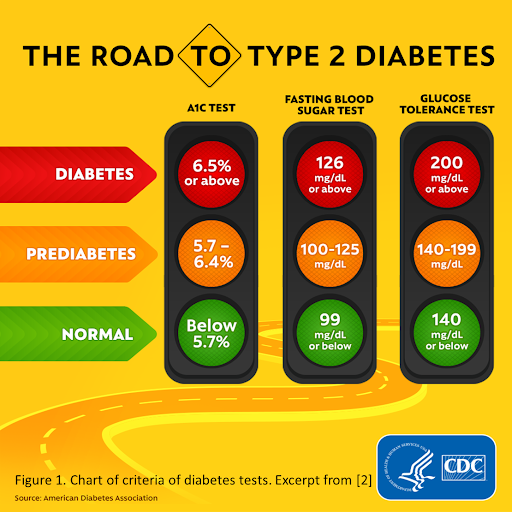
In type 1 diabetes, patients’ bodies cannot produce any or enough insulin, which is considered related primarily to genetics. In type 2 diabetes, which accounts for 90% of diabetic patients, bodies can produce insulin but cannot react to or use it properly. Since type 2 diabetes is the most common type of diabetes mellitus, the main focus of this research paper is its treatment. The three primary diabetes tests for diagnosis are the HbA1c test, and fasting plasma glucose (fasting blood sugar) test and glucose tolerance test. Their standards are as shown in Figure 1 [2]. They all measure the blood glucose level, with a lower value indicating a healthier condition. The prediabetes stage is still reversible, whereas diabetes is not curable with current medicine.
The treatment suggested in the beginning stages of diabetes or in prediabetes is to have a proper diet and exercise more. However, if the lifestyle change does not work well in improving the symptoms, medications would be prescribed. Metformin, a medication that decreases glucose production in the liver, would be suggested most of the time. Sulfonylureas and meglitinides are two frequently used insulin secretion enhancers that are used as add-on oral antidiabetic drugs (OAD) for metformin. Since meglitinides are newer compared to sulfonylureas, a review of this class of drug is important.
Meglitinides were first introduced in 1995 [3]. They are a class of medication that are short-acting and easy to absorb, which means their efficacy shows quickly and disappears in a short period of time. They are also actively metabolized in the liver and rapidly excreted. Therefore, there is a smaller risk of drug accumulation for meglitinides-treated patients. Because the diabetes and pre-diabetes patient group is becoming younger, the importance of assessing the effect of age on the efficacy of meglitinides and understanding the efficacy is increasingly important and relevant to more people.
Methods
The method used in this research to obtain information and data for analysis was reviewing reports and studies related to meglitinides. Results found based on the reports are compared and analyzed to answer the research questions.
Selection criteria
Types of studies: studies providing the patients and methods and results
Types of participants: type 2 diabetes patients
Types of outcome measures: HbA1C values and Fasting Plasma Glucose (FPG) level
Results and Discussion
Meglitinides
Type 2 diabetes patients are usually prescribed metformin treatment if diet and exercise changes are ineffective. This treatment is sometimes combined with other drugs like sulfonylureas and meglitinides. Meglitinides, also called glinides, are a class of short-acting drug. The two most frequently used and qualified drugs in this class are repaglinide and nateglinide. The mechanism of the relatively new glinides is very similar to sulfonylureas. They are both insulin secretagogues that stimulate insulin production in β cells. It is suggested to administer between 0.5 mg and 4 mg of meglitinides every day before meals.
Potential Efficacy-impacting Factors
- 1. Age
In a study with 339 type 2 diabetes patients treated with 120 mg nateglinide, the results show that the mean reduction in HbA1C level in patients aged younger than 65 years is 0.42%, while for patients older or equal to 65 years it is 0.52%. The respective standard deviations are 1.25% and 0.88%. Since the standard deviations overlap, the difference is not statistically significant. This shows that the efficacy of nateglinide is not significantly influenced by age [4].
The results collected from the study are shown in Figure 4. Nateglinide performed better when it was taken before food, no matter what the meal types were. Neither types of meals nor timing of administration showed any significant difference in plasma nateglinide levels and glucose excursions. The peak plasma glucose of high-fat and high-protein meals was similar but lower than the one of high-carbohydrate. Taking high-fat meals could also lead to a lower plasma insulin concentration peak. Lastly, meal types did not show any effect on the plasma nateglinide [5].
Based on the observations of the figure, the types of meals do not significantly influence the efficacy of nateglinide either before or after meals. The results obtained from each category are analogous. Additionally, nateglinide always reacts better when it is taken 10 minutes before meals which is further supportive evidence for the suggestion it promotes preprandial administration. However, the same default in the previously mentioned study also exists in this one, because the sample is not large enough to conclude effectively. If there were more participants, the results would be more accurate and valuable for more people.
- 3. Renal Function
In an open-label, parallel-group study, 40 female and male participants were selected to engage in a trial which aims to examine the effects of renal failures on the pharmacokinetics of nateglinide. Participants that might have any medical condition other than renal failures that may affect the efficacy of nateglinide were excluded. The subjects were separated into four groups, group D, group HD, group RI and group HRI. 10 patients diagnosed with type 1 or 2 diabetes for at least 6 months and undergoing hemodialysis for end-stage renal disease were included in group D, while another 10 patients with moderate to severe renal insufficiency who had not undergone hemodialysis in the 6 months before the study were included in group RI. Each participant with renal insufficiency is matched with a healthy subject with similar health conditions, including age, sex, height and weight. These healthy participants were included in either group HD or group HRI, corresponding to their matched participants.
After a 10-hour overnight fast, participants were given a 120-mg single dose of nateglinide 10 min before an 800 kcal breakfast at 8 o’clock on the study day. Blood samples were collected pre-dose and 0.25, 0.5, 1, 1.5, 2, 2.5, 3, 4, 6, 9, 12 and 24 hours after the dose. Patients’ blood samples were also collected 36 and 48 hours post-dose.
The results showed similar results on the plasma drug concentration peak and time to plasma drug concentration peak in all four groups. Plasma drug concentration increased rapidly in both group D and group HD after meals. The peak drug concentration was reached at 0.5~2.5 hours and 0.5~1.5 hours for these two groups and was similar two hours after meals in these two groups. The time to plasma concentration peak was 0.95 hours and 0.78 hours which are not significantly different. In group RI and group HRI, the peak plasma concentration was achieved at 0.8 and 0.65 hours after a meal while the peak was reached at 0.5~1.5 hours and 0.5~1.0 hours [6].
The main takeaway of this study is that moderate to severe renal insufficiency does not impact the efficacy of nateglinide. However, the peak drug concentration was postponed in patients with renal insufficiency. The prolonged elimination may lead to drug accumulation. In conclusion, renal dysfunction does not significantly affect the efficacy of nateglinide.
Monotherapy (Repaglinide versus Nateglinide)
A six-week, randomized, parallel-group, open-label study compared the efficacy of two types of meglitinides, repaglinide and nateglinide. 150 people aged older than 18 years with type 2 diabetes and a BMI of 24~42 kgm2 were involved. In the previous three months before the study, they used diet control and exercise as their only treatment. They were randomly assigned with repaglinide (n=76) and nateglinide (n=74). Their HbA1C values and Fasting Plasma Glucose (FPG) values were collected in the 4th, 8th, 12th and 16th weeks. The medications were taken 30~1 min before meals. In the initial 3-week period of titration, the dosages were increased gradually from 0.5 mg to 1.0 mg to 2.0 mg to 4.0 mg for repaglinide and from 60 mg to 120 mg for nateglinide. The maximum total amount of drugs taken in was controlled below the maximum dosages allowed. Participants also recorded their Self-Monitoring Blood Glucose (SMBG) 2 hours after breakfast, 2 hours before and after lunch, 2 hours before dinner, bedtime and at 2 a.m.
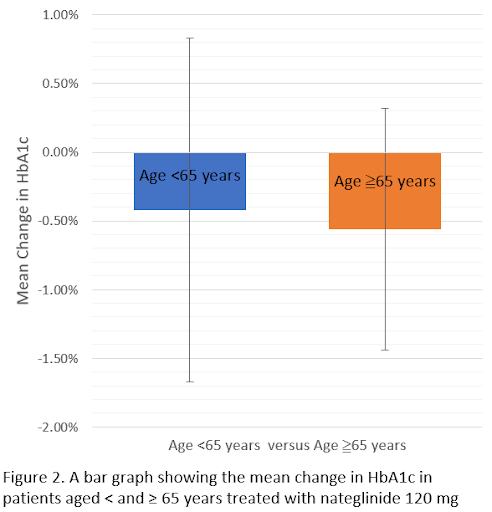
In a study with 339 type 2 diabetes patients treated with 120 mg nateglinide, the results show that the mean reduction in HbA1C level in patients aged younger than 65 years is 0.42%, while for patients older or equal to 65 years it is 0.52%. The respective standard deviations are 1.25% and 0.88%. Since the standard deviations overlap, the difference is not statistically significant. This shows that the efficacy of nateglinide is not significantly influenced by age [4].
The results show an insignificant correlation between age and efficacy. However, the methods and the duration of the study and the criteria for selecting participants are not thoroughly mentioned. Besides, very few studies focus on this factor, which makes it difficult to corroborate the results. Therefore, further research relating to this factor is needed in order to make a more evident conclusion. However, that is not to say these results should be disregarded, but more samples or studies with supportive results would be more convincing and reliable. Hence, in conclusion, based on this research, age does not significantly affect the efficacy of meglitinides.
- 2. Food Intake
- Timing of administration of nateglinide
In a double-blind, placebo-controlled, randomized four-way cross-over designed study, 12 healthy people were selected to take nateglinide (60 mg) either 10 min before a meal, 1 min before a meal or 10 min after a meal. The meals provided were high-carbohydrate and approximately 500 kcal. The trials were conducted on 4 separate study days with an interval of one week as a washout period between them. Plasma glucose levels tests were taken several times before and after the meal. This study was designed to test the efficacy of nateglinide between premeal and postprandial administration.
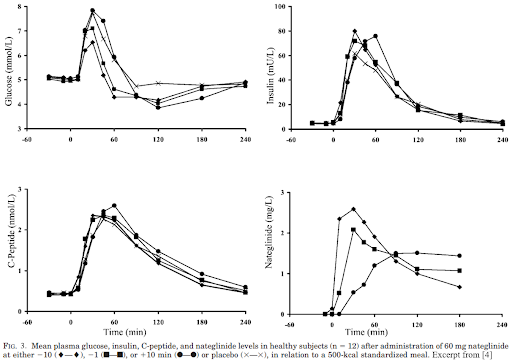
The results of the study are shown in Figure 3. The preprandial administration successfully and significantly lowered the peak plasma glucose level, especially the 10 min-preprandial one. In contrast, the peak blood sugar level did not differ much from the placebo group. The absorption of the drug was delayed if taken after meals which led to delayed hypoglycemic responses. The peak plasma insulin also increased with premeal administration and was reached within 30 min after meals. The peak plasma insulin was also increased by a similar amount in postprandial administration but the peak-reaching time was postponed by 15 minutes. Besides, taking in nateglinide before meals led to a higher drug concentration peak [4].
The results from this study show that preprandial administration of nateglinide leads to better efficacy and a lower risk of adverse effects. Taking the drug 10 minutes before having any food allows the drug to perform better in reducing the plasma glucose level, increasing plasma insulin level and improving the absorption of the drug. The results are all significant, but the small number of participants and vague standard for selecting participants make the conclusion drawn from the study somewhat weak, because the data may contain some anomalies. Besides, nateglinide may work differently on diabetic patients.
- Types of meals
In a randomized six-way cross-over study, 12 healthy people were selected to carry out trials testing the efficacy of nateglinide in different types of meals, including high-carbohydrate, high-fat and high-protein meals. A nateglinide dose was either taken 10 minutes before or after the meal. This study took seven individual study days with one week in between each study day as a washout period. Data on plasma glucose level, plasma insulin level and drug concentration level were collected.
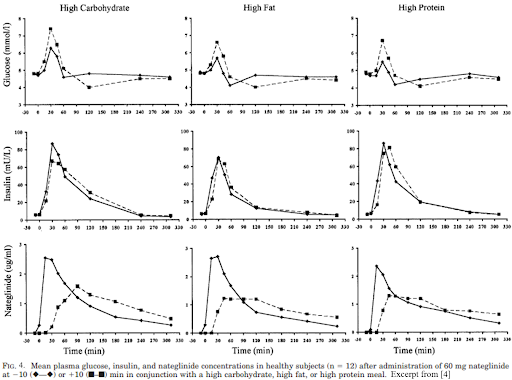
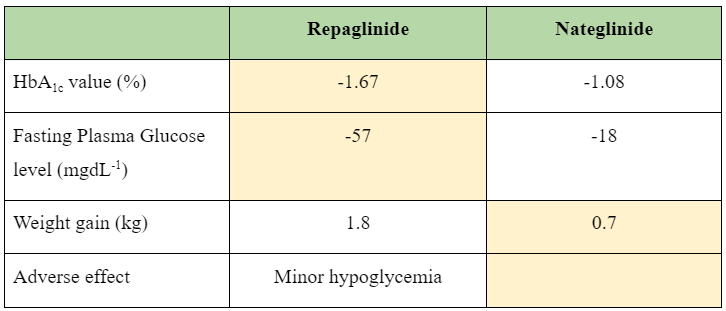
Figure 5. Table of results from a 16-week based monotherapy
Starting from the 8th week, repaglinide performed better in reduction of the HbA1C level and FPG level than nateglinide. 54% of the repaglinide-treated patients reduced their HbA1C to lower than 7%, while 42% of the nateglinide-treated patients obtained the same effect. 40% of the repaglinide-treated patients with an HbA1C level of more than 8% reduced the values to less than 7%, while only 8% of the nateglinide-treated patients with the same condition achieved this. The mean HbA1C level was lowered by 1.67% for repaglinide and 1.08% for nateglinide. The mean FPG level was 156 mgdL-1 and 183 mgdL-1 for the two medications. Moreover, the mean reduction was 57 mgdL-1 and 18 mgdL-1. Repaglinide-treated participants had a higher gain in weight at 1.8 kg, while nateglinide participants saw a 0.7 kg increase. Besides, 7% of repaglinide-treated patients had minor hypoglycemic events, which were 0.016 events each patient per month, while zero cases were reported from the nateglinide-treated patients [7].
Repaglinide has a significantly better performance in reducing the HbA1c level and FPG level than nateglinide. It can effectively decrease the FPG value almost three times more than nateglinide. However, some side effects accompany taking it. More weight is gained compared to nateglinide. The risk of having slight hypoglycemia is also higher.
Comparison with Sulfonylureas
- Glimepiride versus Repaglinide
In a twelve-month, randomized, double-blind, comparative-trials study, 132 type 2 diabetes patients were included to analyze the differences in the efficacy of repaglinide and glimepiride (a long-acting sulfonylurea). They were all nonsmokers with normal blood pressure, normal renal functions and no coronary heart disease, which might affect the efficacy of drugs. There was a 4-week washout period and an 8-week titration period before the 1-year treatment began. The doses started from 1 mg of repaglinide per day or 1 mg of glimepiride per study day. The calories of everyday meals were controlled in the range of 1400~1600 kcal. The blood samples were collected every three months.

After twelve-months treatment, both groups demonstrated a similar significant reduction in HbA1C and FPG levels. HbA1C values were decreased by 1.2% in the repaglinide group and 1.1% in the glimepiride group. FPG levels were reduced by 38 mgdL-1 in the repaglinide group and 39 mgdL-1 in the glimepiride group [8].
The results showed that both repaglinide and glimepiride are effective medications in controlling the blood sugar level in type 2 diabetes. They also proved that they work effectively as monotherapy.
- Repaglinide versus Glipizide
In a one-year, double-blind, parallel-group, comparative-trials study, 256 type 2 diabetes patients aged 40~70 years with BMI 20~35 kgm-2 and HbA1C values of 6.5%~12.8% were included to compare the effects of repaglinide and glipizide, the shortest-acting sulfonylureas. 175 patients were assigned repaglinide, while 81 participants were assigned glipizide. The drug dosage was either 1 to 4 mg of repaglinide given 30 minutes before each meal or 5 to 15 mg of glipizide given 30 minutes before breakfast per day. During the titration period, the dose level received was gradually increased after a titration visit if the blood sugar control reached the target.
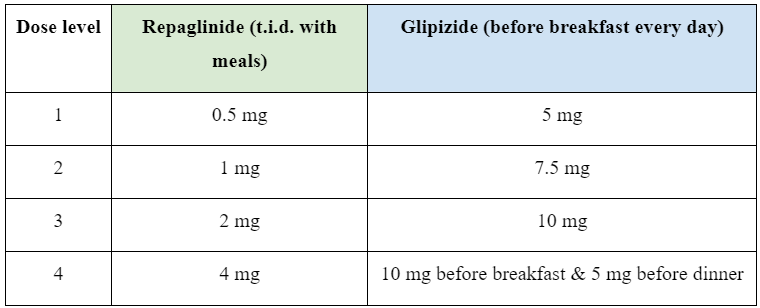
Figure 7. Table of dose levels
After three titration visits, the one-year maintenance period began, and the weight, blood pressure, FPG and HbA1C were measured every three months.
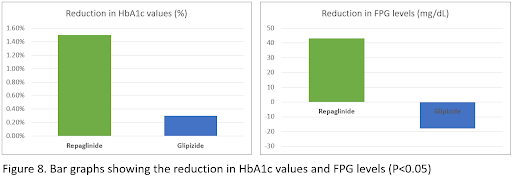
At the end of the study, 80% of patients in the repaglinide group and 72% of patients in the glipizide group had completed the study because of adverse effects or ineffective therapy. The final results demonstrate a sharp contrast between the efficacy of the two medications. In oral hypoglycemic agents (OHA) naive, the HbA1C was decreased by 1.5% in the repaglinide group and by 0.3% in the glipizide group. The FPG level was reduced by 43.2 mgdL-11 in the repaglinide group and increased by 18 mgdL-1 in the glipizide group. In both groups, the risks of having minor hypoglycaemic events were very similar (15% in the repaglinide group and 18% in the glipizide group). Moreover, repaglinide-treated patients showed a lower risk of getting hypoglycemia when meals were missed [9].
In conclusion, repaglinide had superiority over glipizide in blood sugar control. Repaglinide is a more effective oral antidiabetic agent in controlling HbA1C values and FPG levels compared to glipizide. However, both of them have small risks of causing slight hypoglycaemic events.
In combination
- With Metformin
- Nateglinide + Metformin
In a randomized, double-blind, parallel-group study, 467 type 2 diabetes patients treated previously with metformin for at least 3 months were included. They were asked to take at least 1500 mg of metformin each day before the study. The health condition requirements included BMI 20 to 35 kgm-2, HbA1C 6.8~11%, FPG level lower than 270 mgdL-1 and no significant diabetic complications. Before the study began, there was a 4-week run-in period in which maximally 1000 mg of metformin was taken twice a day. Patients subsequently were separated into three groups, nateglinide placebo + metformin 1000 mg b.i.d. group, nateglinide 60 mg + metformin 1000 mg b.i.d. group and nateglinide 120 mg + metformin 1000 mg b.i.d. group. Their blood samples were collected on weeks 4, 8, 12, 16 and 24.
The results showed a great reduction in HbA1C values in the nateglinide 60 mg group and the nateglinide 120 mg group (0.51% versus 0.82%). The FPG level was reduced by 0 mgdL-1 in the nateglinide 60 mg group, 3.6 mgdL-1 in the nateglinide 120 mg group, and 9 mgdL-1 in the placebo group. The weight gain was significantly greater in the nateglinide 120 mg group (+1.0 kg) [10].
This study showed that a larger amount of nateglinide in addition to metformin therapy has better efficacy in reducing the blood sugar level than metformin with a smaller amount of nateglinide. However, more nateglinide can also lead to a greater weight gain at the end of the therapy.
- Repaglinide + Metformin versus Nateglinide + Metformin
A one-year, open-label, parallel-group, randomized study was conducted to compare the efficacy of the combination of repaglinide and metformin and the combination of nateglinide and metformin. 192 type 2 diabetes patients were included. They were all adults (older than 18 years) with a BMI of 24~42 kgm-2 and HbA1C values between 7% and 12%. Patients treated with other therapies had a 4-week run-in period of metformin treatment. The dosage ended up with 1000 mg b.i.d. (twice a day) before the maintenance period began. 96 participants were assigned to repaglinide, and the other 96 subjects were assigned to nateglinide. They were taken 1~30 minutes before each meal. In the 2-week titration period, the dosage of repaglinide would be optimized from 1 mg to 2 mg to 4 mg per meal, and the one of nateglinide would be 120 mg each meal if the self-monitoring blood glucose values were between 80 mgdL-1 to 140 mgdL-1. Then, the 14 weeks of maintenance began. The HbA1C values and FPG levels were the standard measurements for assessing the efficacy of the two combinations of drugs.
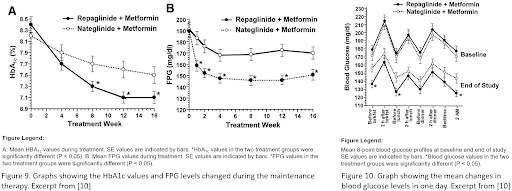
The final HbA1C values were lower in the nateglinide and metformin group than in repaglinide and metformin. In contrast, the change in the values in the repaglinide and metformin group was significantly larger than the one with nateglinide. 59% of the patients in the repaglinide group reduced their values to lower than 7%, while 47% of the ones in the nateglinide group reached this target. The FPG level was decreased by 39 mgdL-1 in the repaglinide group compared to 21 mgdL-1 in the nateglinide group. 48% and 26% of participants reduced their FPG levels to more than 40 mgdL-1 in the repaglinide group and nateglinide group. During the treatment therapy period, no major hypoglycaemic events were reported. However, 7% of repaglinide-treated patients had experienced minor hypoglycemia, while 2% of nateglinide-treated patients had. 38% of participants had also had some adverse effects, including nausea, viral infection, accidental injury, sinusitis, diarrhoea and headache [11].
This study showed that repaglinide with metformin is a statistically significantly more effective drug combination than nateglinide with metformin in type 2 diabetes. It has better control of the blood glucose level and better performance in reducing the HbA1C values and FPG level. However, this combination causes slightly more minor hypoglycaemic events than with nateglinide.
Further Discussion
As more young people are being diagnosed with type 2 diabetes, the need to assess the effective medications in such diabetic patients is becoming more important. Meglitinides is one of the classes of drugs for it. It is a class of short acting drugs including repaglinide and nateglinide.
According to [4], there is no significant difference between the efficacy in people older than 65 years and people younger than this age. The study has a relatively large sample size of 339 patients. In other studies discussed in this report, few minor hypoglycemic events were reported. On one hand, the drug is effective for young people as it has low risk of causing minor side effects. On the other hand, meglitinides is a safe and effective medication for the elderly. It is short- and fast-acting which means drug accumulation is not a big concern and it is good for older people with weak metabolism. Lower risk of minor hypoglycemia is also a positive sign for the older patient group. Besides, the common side effect of meglitinides is hypoglycemia and weight gain. Younger patients tend to have a better metabolism system and faster recovery process compared to older patients which means that they are able to deal with or bear with the side effects themselves.
The most frequently reported adverse effect is minor hypoglycemia. In a study comparing repaglinide and glipizide, 15% and 18% of the participants had experienced minor hypoglycemic events which are not significantly different [9]. In two studies comparing repaglinide with nateglinide (both are meglitinides), they all found a higher risk of having hypoglycemia in the repaglinide group (7%:0% & 7%:2%) [7, 11]. Weight gain is also reported in some of the studies. Nateglinide showed a superiority over repaglinide on gaining less weight (1.8kg:0.7kg) [7]. The results also showed that the greater the dosage of nateglinide there is, the greater weight gain it would cause [10]. This shows that taking nateglinide is a better option when wanting to avoid hypoglycemia and too much weight gain. The risk of having hypoglycemic events, overall, is low and most of the cases are minor.
In terms of affordability, the price of meglitinides is not expensive. The price per tablet is $0.30~$0.79 which is similar to sulfonylureas and metformin (sulfonylureas: $0.03~$0.81; metformin: $0.15~$0.83) [12].
Conclusion
Meglitinides is a class of short-acting medications for treating diabetes similar to sulfonylureas. It is usually used as an add-on oral agent in combination with metformin. Because of its short duration of action, drug accumulation is not common in meglitinide treatment. Factors such as age and renal functions do not significantly affect its efficacy, but it is suggested to administer it before meals to better control plasma glucose levels. Meglitinides, especially repaglinide, stand out in monotherapy. Compared to sulfonylureas, it can reduce the HbA1C values and FPG levels more effectively while also leading to less weight gain. The risk of getting hypoglycemia is similar in both treatments. It also performs very well in combination with metformin [13]. Metformin is not suggested for patients aged older than 80 years and with renal failures, while meglitinides are a good alternative option when this is the case. Moreover, the price of meglitinides is not very different from other types of medications like metformin or sulfonylureas, which means it is not very expensive. In conclusion, age is not a limit to the efficacy of meglitinides, while it is an effective monotherapy and add-on medication to metformin.
References
- “Diabetes.” World Health Organization, World Health Organization, https://www.who.int/health-topics/diabetes#tab=tab_1.
- “Diabetes Tests.” Centers for Disease Control and Prevention, Centers for Disease Control and Prevention, 10 Aug. 2021, https://www.cdc.gov/diabetes/basics/getting-tested.html.
- Malaisse WJ. Pharmacology of the meglitinide analogs: new treatment options for type 2 diabetes mellitus. Treat Endocrinol. 2003;2(6):401-14. doi: 10.2165/00024677-200302060-00004. PMID: 15981944.
- S. Mallows, C. Guitard, et al. Nateglinide is effective and safe in elderly patients with type 2 diabetes. Diabetes Research and Clinical Practise. Volume 50, Supplement 1, 73, September 01, 2000
- Luzio SD, Anderson DM, Owens DR. Effects of timing of administration and meal composition on the pharmacokinetic and pharmacodynamic characteristics of the short-acting oral hypoglycemic agent nateglinide in healthy subjects. J Clin Endocrinol Metab. 2001 Oct;86(10):4874-80. doi: 10.1210/jcem.86.10.7911. PMID: 11600556.
- Devineni D, Walter Y, Smith HT, et al. Pharmacokinetics of nateglinide in renally impaired diabetic patients. J Clin Pharmacol 2003 Feb
- Rosenstock J, Hassman DR, Madder RD, et al. Repaglinide versus Nateglinide monotherapy. A randomized multicenter study. Diabetes Care 2004
- Derosa G, Mugellini A, Ciccarelli L, et al. Comparison between repaglinide and Glimepiride in patients with type 2 diabetes mellitus: a one-year, randomized, double-blind assessment of metabolic parameters and cardiovascular risk factors. Clin Therapeutics 2003
- Madsbad S, Kilhovd B, Lager I, et al. Comparison between repaglinide and Glipizide in type 2 diabetes mellitus: a 1-year multicenter study. Diabet Med 2001
- Marre M, Van Gaal L, Usadel KH, et al. Nateglinide improves glycaemic control when added to metformin monotherapy: results of a randomized trial with type 2 diabetes patients. Diabetes Obes Metab 2002
- Raskin P, Klaff L, McGill J, et al. Efficacy and safety of combination therapy. Repaglinide plus Metformin versus Nateglinide plus Metformin. Diabetes Care 2003
- “Prescription Drug Information, Interactions & Side Effects.” Drugs.com, Drugs.com, https://www.drugs.com/.
- JF Blicklé. Meglitinide analogues: a review of clinical data focused on recent trials. Diabetes & Metabolism, Volume 32, Issue 2, 2006




